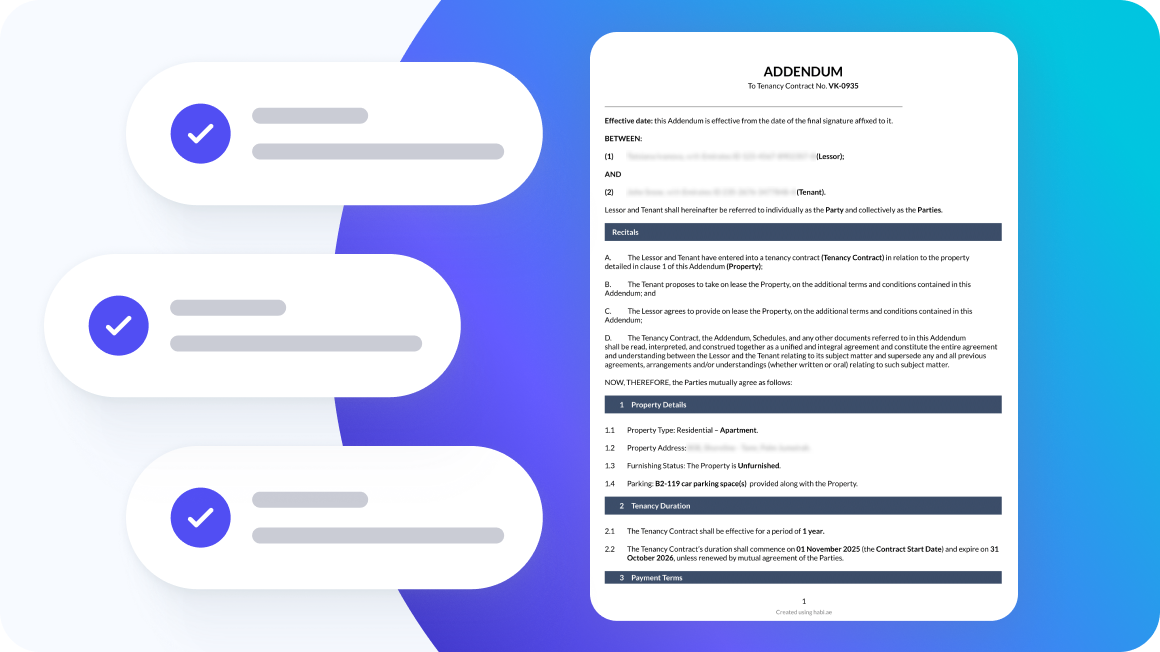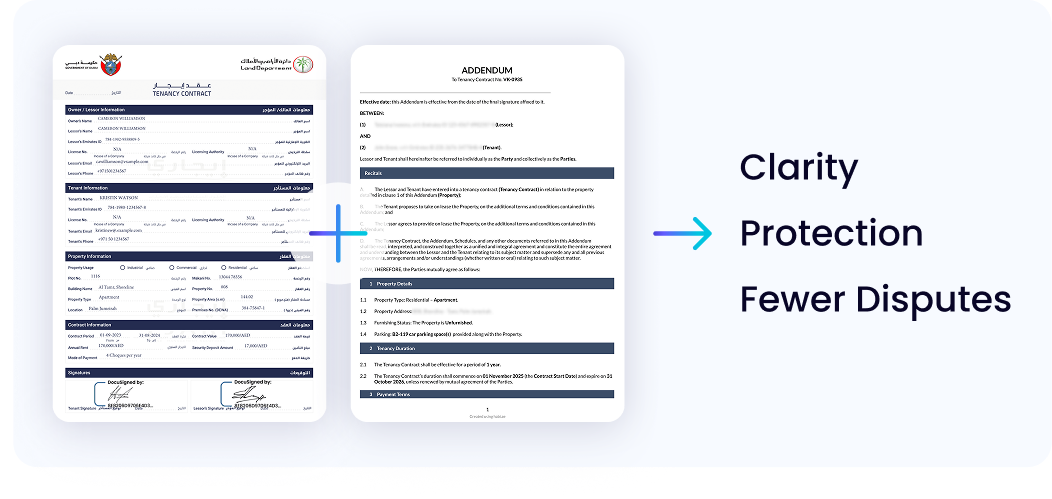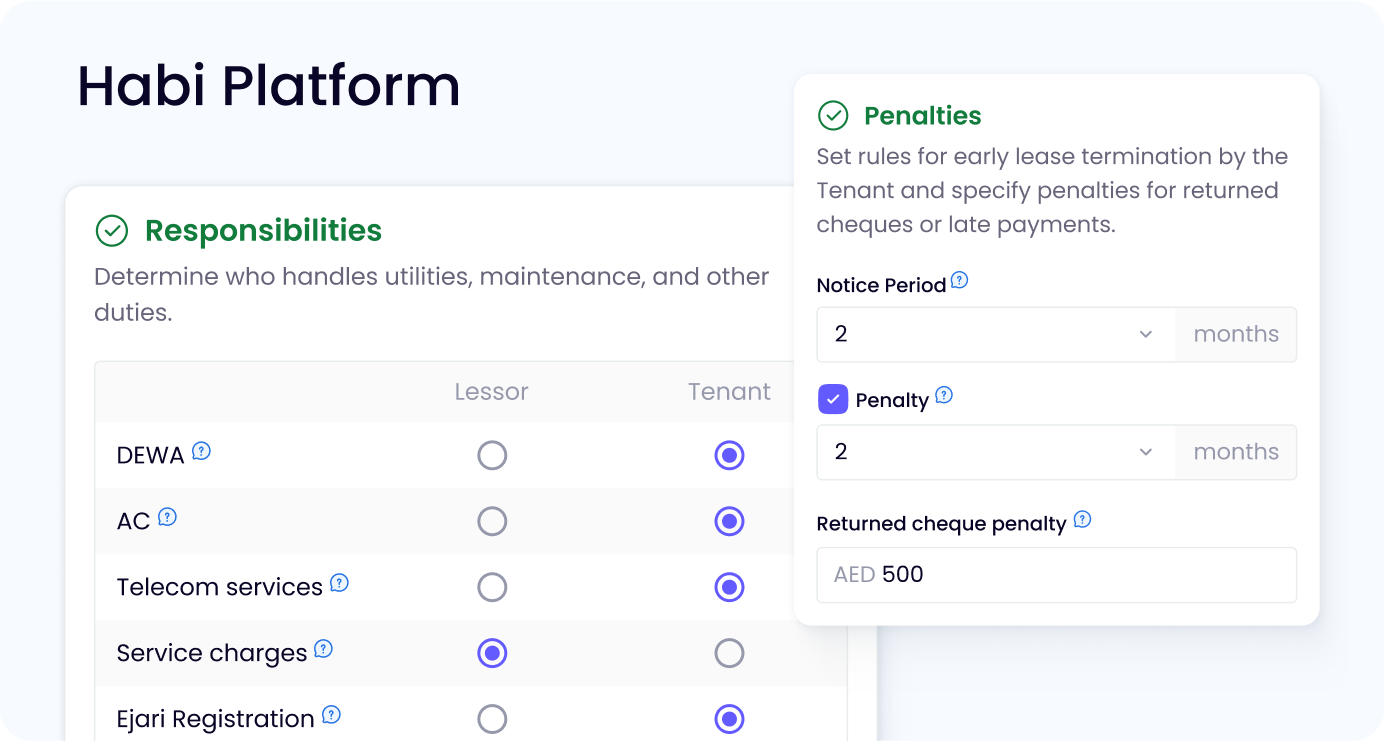October 7, 2025

The standard tenancy contract template provided by the Dubai Land Department (DLD) serves as a foundational document for any rental agreement. It covers essential terms, but is intentionally general in its scope.
This generality can leave significant room for interpretation, potentially leading to disagreements between landlords and tenants. An addendum can be added to address this gap.
The role of the addendum is to specify additional conditions, responsibilities, and rights that are not detailed in the main template. When executed correctly, a comprehensive addendum is a critical tool for protecting the interests of both parties and preventing unnecessary conflict by establishing clear, mutually understood expectations from the outset.

Unclear or incomplete addendum terms can lead to costly disputes and misunderstandings.
These risks can be effectively managed through the careful drafting and inclusion of specific clauses in a tenancy agreement addendum.
The following clauses should be given careful attention when drafting an addendum to create a more secure and clear tenancy agreement.
Ensure that payment schedules include clear deadlines and amounts. Avoid vague wording that may allow either party to exploit loopholes, leading to significant inconvenience or conflict.
Define who is responsible for utility services like DEWA, district cooling/chiller, telecom, or gas, if required. Specify not only who pays the bills but also who is obligated to register, maintain, and subsequently disconnect each account.
Include a clause specifying what constitutes minor versus major maintenance and assign responsibility accordingly. It is common to state that repairs below a set amount, such as AED 500 or AED 1,000, fall under the tenant’s responsibility, while costs exceeding that threshold are borne by the landlord.
Highlight whether service charges are included in the rent or if they are a separate responsibility for the tenant. If the intention is for the tenant to bear this cost, this must be explicitly stated in the addendum. The rent should be adjusted to reflect this allocation to avoid the tenant effectively paying twice.
While the legal responsibility for Ejari registration falls upon the landlord, it is standard practice, often stipulated within the tenancy contract, for the tenant to manage this process and bear the cost. The addendum should explicitly state if the tenant is to handle the process and must include a clear deadline for its completion.
Define the consequences for late rent payments or bounced cheques. This includes specifying any grace period and the exact fee structure for penalties. Clear consequences set expectations and reduce disputes.
If the property is furnished, include a detailed inventory list and photographic condition reports at move-in and move-out stages. This documentation is essential for preventing arguments over missing or damaged items at the end of the tenancy.
If early termination is permitted, the terms must be established in advance. Specify the required notice period and any financial compensation due to the landlord. Clear rules minimise disagreement if the tenant’s circumstances change.
To mitigate vacancy loss, include a clause that allows the landlord or agent reasonable access for property viewings with at least 24 hours’ notice to the tenant during the final months of the tenancy.
Address whether subleasing is permitted. If not, explicitly prohibit it to avoid unauthorised accommodation or issues with short-term rentals.
Specify rules regarding pets and smoking. Clearly outlining these can prevent disputes related to damage, noise, or compliance with building regulations.
Clarify that the building insurance remains the landlord’s responsibility. State that the tenant is responsible for securing their own contents and liability insurance. Make it clear that the landlord bears no liability for loss or damage to the tenant’s belongings.
Outline terms for property modifications. Tenants should know whether they are allowed to make changes, as well as their obligation to restore the property if alterations occur.
Include a provision for situations where properties become uninhabitable due to external factors, ensuring both parties understand their obligations under such circumstances.
Define the expected condition of the property upon move-out. This includes cleaning standards and whether a full repaint is required or only touch-ups for minor damage.
Specify intervals for routine air conditioning servicing and duct cleaning. Clearly state who is responsible for the arrangements and payments to ensure consistent upkeep.
Include a clause stating that the addendum forms an integral part of the tenancy contract. Furthermore, it should state that in the event of any conflict between the addendum and the standard DLD contract, the terms of the addendum will take precedence.
A thorough and well-considered addendum is not just an addition to the tenancy contract, but a primary instrument for defining a transparent landlord-tenant relationship. By investing time in its creation, landlords can secure their asset, ensure a stable rental income, and establish a foundation for a dispute-free tenancy.
For landlords seeking a streamlined and secure method to manage tenancy agreements, Habi offers a comprehensive digital solution. Our platform allows you to draft, sign, and register your Dubai tenancy contract and Ejari through a single, guided online process.
You can generate fully compliant long-term rental contracts and detailed addendums yourself, without requiring intermediaries or specialised legal knowledge, ensuring your documents are legally correct and designed to protect against disputes. The entire process is facilitated with digital signatures for both parties from any device. As an officially licensed entity in Dubai authorised for Ejari registration, Habi guarantees that all created documents are fully RERA-compliant and accepted by all relevant authorities.

The primary risk is ambiguity. Without clear terms, both landlords and tenants are exposed to disputes over financial responsibilities (rent, utilities, maintenance), property condition, and obligations upon move-out. This ambiguity can lead to financial loss, legal issues, and a strained landlord-tenant relationship.
Yes. The addendum is the perfect place to explicitly state your policies on pets, smoking, or even large gatherings. Clearly outlining these rules helps prevent damage and disputes with neighbours or building management.
Without a "Break Lease" clause, you could face a prolonged dispute. The addendum should predefine the terms for early termination, including the required notice period (e.g., 60 days) and any financial compensation (e.g., forfeiture of the security deposit or payment of a pre-agreed fee).
Absolutely. The standard contract may not explicitly address subleasing. Your addendum should clearly state whether subleasing is permitted or not. Prohibiting it prevents unauthorised occupants and illegal short-term rentals, which often violate building rules.
